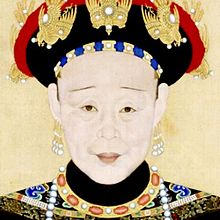- Empress Xiaoherui
-
Niuhuru, Empress Xiao He Rui
孝和睿皇后
Reign 1801–1820 Predecessor Hitara, Empress Shu Rui Successor Niuhuru, Empress Mu Cheng Spouse Jiaqing Emperor Issue Miankai, Prince Chun Ke 惇恪親王綿愷
Mianxin, Prince Duan Huai 瑞懷親王綿忻
Unnamed Princess (Died in Childhood)Father Niuhuru Gongala (鈕祜祿恭阿拉) Born 1776 Died 1850 (aged 73–74) Empress Xiao He Rui (Chinese: 孝和睿皇后), 1776–23 January 1850, was the second Empress Consort of the Qing Dynasty Jia Qing Emperor who ruled China from 1769 till 1820.
Contents
Biography
Empress Xiao He Rui née Niohuru (鈕祜祿氏) was Manchu of origin. She was the daughter of Gongala, who served as President of the Board of civil appointments during Emperor Qianlong's reign. Her brother was Duke Hoshitai.
Lady niohuru was born in the 41st year of the Qian Long Emperor's reign. She entered the Forbidden City as a secondary wife to Prince Yong Yan. It is not recorded when she entered but in 1793 she gave birth to a daughter. She also had two sons, the third prince, Mian Kai, and the fourth prince, Mian Xin.
In 1796 the Qianlong Emperor abdicated in favor of his son Yong Yan who ascended the throne as the Jia Qing Emperor. As secondary wife Lady Niohuru was given the title of Noble Consort. The Emperor's first wife, Empress Xiao Shu Rui, died of illness after being Empress for only one year. She left a son, the second Prince Minning 旻寧. (The first prince died shortly after birth). Lady Niohuru was put in charge of the women's quarters and promted to a first rank consort Imperial Noble Consort. Jiaqing wanted to crown Lady Niohuru empress but had to wait till after the mourning period of his first empress. In 1799 Qianlong died and the ceremony for Lady Niohuru crowned empress was delayed till 1801.
Lady Niohuru was very nice to Prince Minning, although he was not her own child. She took care and looked after him. The relationship between the stepson Prince Minning and the stepmother Empress Xiao He Rui was very harmonic and well-developed[1]. When the Jia Qing Emperor died, he had not yet appointed his successor, and the decision was therefore left to the Empress Dowager. Prince Minning was at the city of Chengde. Lady Niohuru announced Minning as successor even before the will was officially opened. She ordered her servants to deliver her message across 500 kilometres as fast as possible to Prince Minning. Minning, now, the Dao Guang Emperor, was extremely gracious of Lady Niohuru's decision. He said that she is a very broad-minded person, not misusing her task to appoint an Emperor by taking the opportunity to name her own sons as Emperors.[2]. Daoguang granted Lady Niohuru the title of Empress Dowager Gong Ci (Chinese: 恭慈皇太后). She moved into the Palace of Longevity and Health[3].
In 1835 Lady Niohuru celebrated her sixtieth birthday. For this celebration Daoguang wore his formal court regalia. He first went to the Hall of Central Harmony to read aloud a congratulation memorial. He then mounted a cart, rode through the Right wing gate, to the Left Eternal Health Gate where he disembarked. Carrying the memorial in both his hands, the emperor was attended by all the Mongol and imperial princes, grand secretaries and grand councellors. After the emperor gave his message and gifts, the retinue jointly gave her a court sceptre[4].
On 10 April 1838 the Empress Dowager, joined by the Daoguang Emperor, visited the Western Qing tombs for 13 days[5].
Lady Niohuru died in the twenty-ninth year of Emperor Daoguan'g's reign in the twelfth month[6]. After her death she was given the posthumous title of Empress Xiao He Rui. She was interred in a separate tomb near the Changling mausoleum amidst the western Qing tombs.
Full posthumous title:
- Empress Xiào Hé Gōng Cí Kāng Yù ān Chéng Qīn Shùn Rén Zhèng Yìng Tiān Xī Shèng Ruì (孝和恭慈康豫安成钦顺仁正应天熙圣睿皇后).
Children
- Jaiqing's seventh daughter (1793–1795).
- Prince Miankai (绵恺) (1795–1838) married the daughter of Fuqing (福庆) of the Niohuru clan.
- Prince Mianxin (绵忻) (1805–1828) .
References
Sources
- Draft history of the Qing dynasty. 《清史稿》卷二百十四.列傳一.后妃傳.
- Royal archives of the Qing dynasty (清宫档案).
- Qing imperial genealogy(清皇室四谱).
- Qing dynasty Xuanzong’s veritable records (清宣宗實錄).
- Biographies of the Qing dynasty consorts (清历朝后妃列传).
- Weng Tonghe's dairy, (翁同龢日记). Re-isse, ISBN: 9787532556700. Published by: 上海古籍 本社特价书.
- Daily Life in the Forbidden City, Wan Yi, Wang Shuqing, Lu Yanzhen ISBN 0-670-81164-5.
- Betty Peh-Tʻi Wei, (2006) "Ruan Yuan, 1764-1849: the life and work of a major scholar-official in nineteenth-century China before the Opium War". ISBN: 9622097855, published by: Hong Kong University Press.
- http://www.royalark.net/China/manchu11.htm, about the Aisin Gioro familytree
See also
- Category:Qing Dynasty emperors
- Category:Qing Dynasty empresses
- Category:Qing Dynasty imperial consorts
Succession
Empress XiaoheruiBorn: 1776 Died: 1850Chinese royalty Preceded by
Hitara, Empress Shu RuiEmpress of China
1801–1820Succeeded by
Niuhuru, Empress Mu Cheng
Actual successor: Tunggiya, Empress Shen Cheng
Preceded by
Niuhuru, Empress Sheng XianEmpress Dowager of China
1820–1850Succeeded by
Empress Xiao-JingCategories:- 1776 births
- 1850 deaths
- Qing Dynasty empresses
- Qing empresses dowager
- Manchu people
Wikimedia Foundation. 2010.
